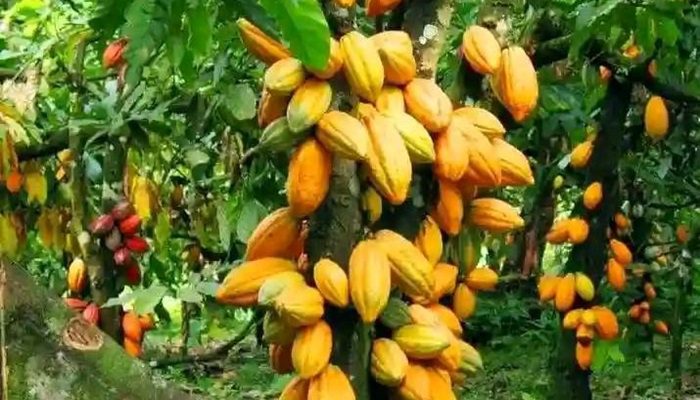Cocoa futures surged to $12,500 on Futures commodities markets, per metric ton in early trading, marking nearly a threefold increase since the beginning of the year.
This historic price hike is raising concerns about the cost of chocolate, one of the world’s most beloved indulgences.
West Africa’s drought drives cocoa crisis
The skyrocketing prices are largely attributed to drought-impacted harvests in West Africa, a region responsible for approximately 75% of global cocoa production.
Ivory Coast, the world’s largest cocoa producer, has faced severe dry conditions, exacerbated by the Harmattan winds from the Sahara desert.
These winds, known for their arid and dusty effects, have further threatened cocoa trees, causing analysts to downgrade the country’s production outlook.
Mark Bowman, an analyst with ADM Investor Services, warned that rainfall is not expected in West Africa for at least the next 10 days, worsening fears of diminished yields.
Ivory Coast’s cocoa output for the 2024-25 season is now estimated at 1.9 million tons, significantly below the initial government projection of 2.1 to 2.2 million tons.
Ripple effects on chocolate prices
The impact of soaring cocoa prices has already been felt by major chocolate producers like Nestlé, Lindt, and Mondelez, all of which raised their prices earlier this year.
Industry insiders predict that consumers could face an unprecedented 10% increase in chocolate prices in 2024, adding to the bitter consequences of cocoa’s record-breaking surge.
While cocoa accounts for only 10% to 20% of the cost of goods sold for chocolate manufacturers, the sharp increase in its price is pushing companies to explore alternative strategies.
Some firms are tweaking recipes to use less cocoa and more artificial flavors to curb costs, a move that might not sit well with chocolate purists.
Market dynamics and industry consolidation
The price rally has also caused reduced activity in cocoa trading, as smaller players exit the market due to high costs. This diminished activity further exacerbates price volatility.
In response to these challenging market conditions, the confectionery industry is seeing signs of consolidation.
Last week, Hershey rejected an acquisition offer from Mondelez, reportedly valued at over $40 billion, underscoring the strategic importance of navigating rising cocoa costs.
A struggle to rebuild stockpiles
The reduced production in Ivory Coast comes at a time when global cocoa stockpiles are already trending lower due to a record deficit in the previous season.
The inability to replenish these reserves is adding pressure on global supply chains, threatening to keep prices elevated well into 2025.
The sweet tooth conundrum
For consumers, the surge in cocoa prices ultimately translates to higher costs at the checkout counter.
Whether it’s artisanal truffles or mass-market chocolate bars, the rising cost of the precious bean is making indulgence more expensive.
As West Africa braces for an uncertain harvest and chocolate companies scramble to adapt, the world’s sweet tooth might have to reckon with a bitter reality.
As sector bodies including the International Cocoa Organisation (ICCO) have noted, compared to the dramatic peak seen during the 1970s of around $5,000 a tonne, those figures today would be equivalent to close-on $30,000 a tonne, illustrating that in real terms, the value of cocoa has not kept pace against its former values, meaning the majority of farmers are continuing to earn below poverty line wages of less than $2 a day.
Significantly, as previously reported, the ICCO released its latest revised estimates for the last two years of world production, grindings, and stocks of cocoa beans, revealing that volume supply has dropped 13% to 4.38 million tonnes globally in the past twelve months – which has kept prices high.
In its latest bulletin, the ICCO points out that both the 2022/23 and 2023/24 seasons were affected by supply challenges and ended with a supply deficit.
World production of cocoa beans for the 2023/24 season ended with a significant reduction as challenging weather conditions, diseases and pests took a toll on the major producing countries in West Africa.
The organisation’s global figure of 4.382 million tonnes, global production of cocoa beans is now estimated to be 50,400 tonnes higher than the Secretariat’s earlier projection in the previous Bulletin.
Cocoa grindings were also down 4.8% for this year, standing at 4.8 million tonnes, despite consumer demand for premium chocolate in particular, remaining especially buoyant.
While global grindings stood at an encouraging 4.816 million tonnes, for the 2023/24 season, cocoa bean shortage and high cocoa prices slowed down processing activities.
Despite this, cocoa demand still outstripped supply, with major manufacturers’ offerings and artisan businesses enjoying notable success in the past year in spite of the elevated bean prices.
As Confectionery Production has reported, industry insiders have highlighted the issue within supply chains, with considerable concerns being raised across the industry.
- Trump slaps tariffs: Ghana, UK-10%, EU-20%, others-50% - 2 April 2025
- BoG policy rate hike: MPC’s 3-2 vote and reasons - 2 April 2025
- Painter accused of stealing BoG cables granted GH₵1m bail - 2 April 2025




